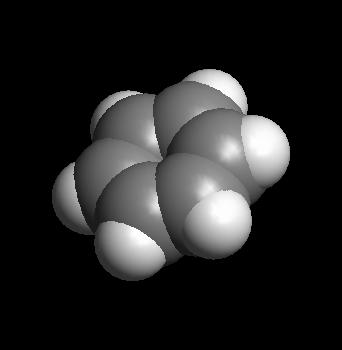|
Such alternating-bond molecules are called conjugated molecules, and some rings with alternating single and double bonds, such as benzene, are aromatic molecules. (The name originally referred to their odor, but now denotes their electronic behavior.) Conjugated molecules such as chlorophyll and carotene, as we shall see in Chapter 19, are used in trapping light energy in plants, and as photoreceptors in the eye. In a sense we even can think of the stability of the H-H bond in a H2 molecule as arising from delocalization: Two electrons, each of which were confined to the vicinity of one H nucleus in the atoms, become decolorized and spread over two nuclei in the H2 molecule, although the electrons are concentrated between the nuclei. The extra stability brought about by this delocalization is part of the strength of the H-H bond. |
 Space-filling model of the benzene molecule, as it would appear if we could actually see it. |